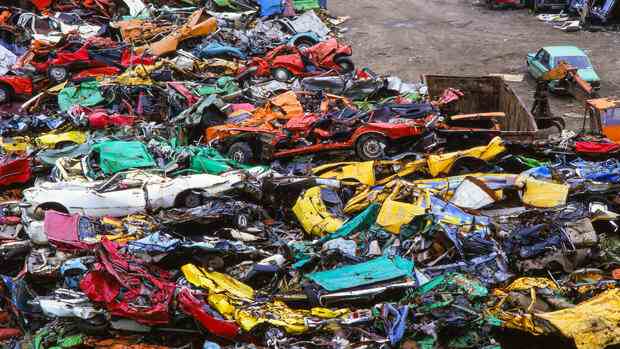Valuable raw materials can be found in car wrecks, ruined buildings and old electronic devices.
(Photo: IMAGO/Peter Widmann)
It is an invaluable treasure that slumbers undiscovered in our cities. Whether in old building ruins, defective electronic devices, in car wrecks or the sewage system – everywhere in our waste there are valuable raw materials that have so far been disposed of carelessly.
Since the resources of primary raw materials and rare earths have become increasingly scarce worldwide and prices on the world markets have been rising, a future technology has increasingly come into focus: “Urban Mining”. The idea behind “urban mining”: Instead of importing raw materials that are often mined under dubious environmental and working conditions, it is better to use the raw materials that are built in our cities.
Because waste prevention and recycling fall short of a true circular economy, urban mining goes one step further – and uses discarded consumer goods, infrastructure, construction waste and landfill deposits as a source of recyclable raw materials.
European cities have gigantic reservoirs of built-up raw materials
The advantages are obvious: Since waste is no longer regarded as an end product but as a permanent part of the value chain, it acquires a completely new economic value. The implementation of a circular economy not only slows down the excesses of raw material extraction in the primary producing countries, but also prevents the consequences of waste incineration and landfilling in Europe.
Top jobs of the day
Find the best jobs now and
be notified by email.
Because the landfill space is limited and the disposal costs of non-recyclable materials are increasing. Last but not least, “urban mining” reduces import dependency, which many companies are looking at with growing concern.
>>Read here: Fight against scarcity of raw materials: medium-sized companies rely on circular economy
European municipalities have gigantic reservoirs of built-up raw materials. Germany alone processes around 1.3 billion tons of various materials every year.
Metals and construction minerals in particular remain bound in consumer goods, buildings and infrastructure for decades. According to estimates, there is more iron slumbering in German garbage dumps alone than the country uses in a year.
In order to keep the raw materials permanently in the resource cycle in the future, manufacturers must already consider the future potential use during product development. The recycling of lithium-ion batteries in electric cars offers enormous potential.
Car batteries and sewage sludge have valuable resources for reuse
If they only have around 70 percent of their initial capacity after ten years of use, they can still be used as intermediate storage in intelligent power grids to compensate for power fluctuations in the grid.
After the batteries have reached the end of their life, up to 96 percent of the metallic materials such as lithium, cobalt or chromium can be recycled in appropriate processing plants and used to produce new batteries.
Unexpected resources are even hidden in the growing amount of sewage sludge and biomass from the municipalities. You will become part of a new generation of gaseous and liquid energy carriers from non-fossil sources.
By using the latest fluidized bed gasification, biomass can be converted into hydrogen-rich synthesis gas, which is synthesized into liquid green fuels in a further process step.
>>Read here: Lithium from old batteries: Krefeld company wants to start first production in Europe
This value creation from waste not only reduces CO2 emissions, it also reduces Europe’s dependence on oil-exporting countries, improves the use of local resources and helps protect ecosystems.
Materials should be recyclable without loss of quality
Both examples of European engineering show that thinking in terms of material cycles is worthwhile and should become the most important field of innovation for a sustainable circular economy.
In addition to the ecological advantages, there are tangible economic opportunities associated with the recycling of limited resources, not only with regard to new sales markets, but also in the competition for the best specialists. Because companies that invest in green technologies are attractive to young people – whether as consumers or as employees.
In order for “Urban Mining” to become a model for success, however, the polluter pays principle must be pursued more consistently. This can only be achieved with appropriate product responsibility.
Closed-loop materials must be given priority in use. This means that you have to be able to recycle a material into the same product without any loss of quality.
Measures such as a material-efficient design, optimized production processes and leasing models, for example for electric car batteries, will bring about noticeable changes in production and user behavior.
“Urban Mining” thus offers the chance for a real change in values and can become the engine for an ecological circular economy worldwide.
The author: Katja Windt is Chief Digital Officer of the steel mill supplier SMS Group.
More: Building without waste: How Interboden builds a recycling office building
